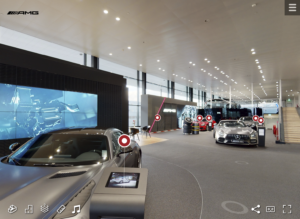
360° Futuristic Industrial Panorama
Illustration by Olivier Gisiger via MidJourney
The rise of virtual tours in the digital age
The advent of the digital era has ushered in a multitude of changes, one of which is the rise of virtual tours. Traditionally used by real estate agents and travel agencies, this tool has evolved into a versatile marketing strategy, thanks to advancements in technology. Today, virtual tours are leveraged by various sectors, from retail to hospitality, education to healthcare. They provide a digital representation of a physical location, allowing users to explore spaces at their own pace, from wherever they may be.
“Virtual tours offer a unique and immersive experience, helping businesses differentiate themselves and make a lasting impression”
In today’s fast-paced world, customers value convenience and accessibility above all else. They’re more likely to interact with a brand that offers a seamless and interactive experience. This is where virtual tours come in. They eliminate the need for physical presence, thus breaking geographical barriers. Moreover, as the pandemic further accelerates digital transformation, virtual tours stand out as a safe and efficient way to explore new places.
The rise of virtual tours is not just driven by technological advancements or changing consumer preferences. It’s also a reflection of the increasingly competitive business landscape. In a world where customers are bombarded with information, businesses need to find new ways to stand out. Virtual tours offer a unique and immersive experience, helping businesses differentiate themselves and make a lasting impression.
The importance of virtual tours for businesses
The importance of virtual tours for businesses cannot be overstated. They offer a competitive edge, helping businesses connect with their audience in a more meaningful and engaging way. Customers are no longer passive recipients of information; they’re active participants who seek interactive experiences. Virtual tours cater to this demand by providing a 360-degree view of a space or a product, allowing customers to interact and engage with the brand on a deeper level.
Virtual tours are more than just a marketing tool; they’re an essential part of the customer journey. They help customers visualize the product or space, which in turn aids in decision-making. According to a study by Google, listings with virtual tours are twice as likely to generate interest. This shows the significant impact of virtual tours on customer engagement and conversion rates.
Furthermore, virtual tours have a direct impact on a business’s bottom line. They not only attract more customers but also increase the time spent on a website, leading to higher conversion rates. Additionally, they offer invaluable insights into customer behavior, helping businesses tailor their strategies accordingly. Thus, neglecting virtual tours can result in missed opportunities and potential revenue.

Benefits of integrating virtual tours into your business model
Integrating virtual tours into your business model has several benefits. Firstly, they enhance your online presence, making your business more visible and attractive to potential customers. Virtual tours also increase engagement by providing an interactive experience. This leads to longer dwell times, higher click-through rates, and ultimately, more conversions.
Virtual tours are a powerful sales tool. They allow customers to explore a product or space at their own pace, without the pressure of a salesperson. This leads to a more informed and confident purchase decision. Moreover, virtual tours can be shared on social media, further amplifying their reach and impact.
Lastly, virtual tours can help reduce returns and complaints. By allowing customers to explore a product or space in detail, they provide a more accurate representation, thus reducing the likelihood of dissatisfaction or misunderstanding. This not only enhances customer satisfaction but also saves resources that would otherwise be spent on handling returns or complaints.
The impact of virtual tours on customer experience
Virtual tours have a profound impact on customer experience. They provide a seamless and interactive experience, making customers feel more engaged and connected with the brand. This not only enhances customer satisfaction but also fosters loyalty. According to a survey by Forbes, 75% of consumers expect a consistent experience wherever they engage with a brand, be it online, in-store, or on social media. Virtual tours help meet this expectation by providing a consistent and immersive experience across all channels.
Furthermore, virtual tours cater to the growing demand for personalized experiences. They allow customers to explore a product or space at their own pace, focusing on areas of interest. This level of interactivity and personalization enhances the customer experience, leading to higher engagement and conversion rates.
Virtual tours also help bridge the gap between online and offline experiences. They provide a realistic representation of a product or space, helping customers visualize what they can expect in real life. This not only aids in decision-making but also enhances the overall customer experience.
High-tech industries embracing virtual tours
High-tech industries are at the forefront of embracing virtual tours. For instance, in the automotive industry, manufacturers use virtual tours to showcase their vehicles’ interiors and exteriors. This allows customers to explore different models and features without visiting a showroom. Similarly, in the retail sector, businesses use virtual tours to provide a virtual shopping experience, allowing customers to explore products in detail.
The education sector also leverages virtual tours to attract prospective students. Universities and colleges use virtual tours to showcase their campuses, facilities, and student life. This not only helps students make an informed decision but also increases the institution’s reach and visibility.
The healthcare industry is another sector that benefits from virtual tours. Hospitals use virtual tours to showcase their facilities and services, helping patients familiarize themselves with the environment. This not only enhances patient experience but also builds trust and confidence in the institution.
Case studies of businesses that benefited from virtual tours
Numerous businesses have reaped the benefits of integrating virtual tours into their marketing strategies. For instance, the British Museum saw a 35% increase in online visitors after launching a virtual tour. Similarly, a study by Carlson Hotels revealed that hotels with virtual tours experienced a 135% increase in online revenue compared to those without.
Another notable example is the real estate industry. According to a report by Matterport, real estate listings with virtual tours receive 87% more views than those without. Furthermore, properties with virtual tours sell up to 31% faster, demonstrating the significant impact of virtual tours on sales and revenue.
These case studies underscore the immense potential of virtual tours. By providing a unique and immersive experience, they help businesses attract more customers, increase engagement, and boost sales. Therefore, ignoring this opportunity could be a critical mistake businesses can’t afford to make.
How to market your virtual tour
Once you’ve created a virtual tour, it’s essential to market it effectively to maximize its impact. Start by optimizing your website for virtual tours. Include a dedicated section for the tour, with clear and compelling call-to-action buttons. Also, ensure that your virtual tour is mobile-friendly, as a large proportion of users access the internet via mobile devices.
Leverage social media to promote your virtual tour. Share snippets of the tour on platforms like Facebook, Instagram, and Twitter, and encourage your followers to explore the full tour on your website. You can also use paid social media advertising to reach a larger audience.
Another effective way to market your virtual tour is through email marketing. Send out an email blast to your subscribers, highlighting the benefits and features of your virtual tour. Include a direct link to the tour to make it easy for recipients to access it.
Conclusion: The necessity of Virtual Tours in the digital age
In conclusion, the digital revolution has transformed the way businesses operate, and virtual tours are a prime example of this transformation. They provide an immersive and interactive experience, helping businesses connect with their audience in a more meaningful and engaging way. By integrating virtual tours into their marketing strategy, businesses can reach a wider audience, increase engagement, and ultimately boost sales. Therefore, in today’s competitive market, neglecting virtual tours is a critical mistake businesses can’t afford to make.
The rise of virtual tours is not just a trend; it’s a necessity. As technology continues to evolve, virtual tours will become even more sophisticated and immersive, providing unprecedented opportunities for businesses to connect with their customers. Therefore, businesses must embrace this digital revolution and integrate virtual tours into their strategies to stay competitive in the digital age.


